Garden Glimpses: Fractured Spring
Climate change continues apace, and this has been one of the oddest springs in my experience. After a ridiculously warm early winter and the earliest recorded blossoms in my garden, Mother Nature seems to have taken a step back, realized how overextended she was, and called a halt to the whole thing. Weeks of below normal cold punctuated with hot stretches that flirted with the mid-80s created a “two steps forward, one step back” mentality in the garden, with nothing blooming in season, and unique bouquets of cut flowers that would normally never blossom together. Drought vied with torrential downpours, and a late freeze crushed the star magnolia blooms at their peak.
When my Daffodil Dinner rolled around in mid-April, we’d just had a week of extremely hot weather, which pushed most of them over the edge, followed by bludgeoning rains that beat what little was left to the ground, the day before the party. Not optimal for what is billed as a celebration of all things narcissus. But the food was still good.

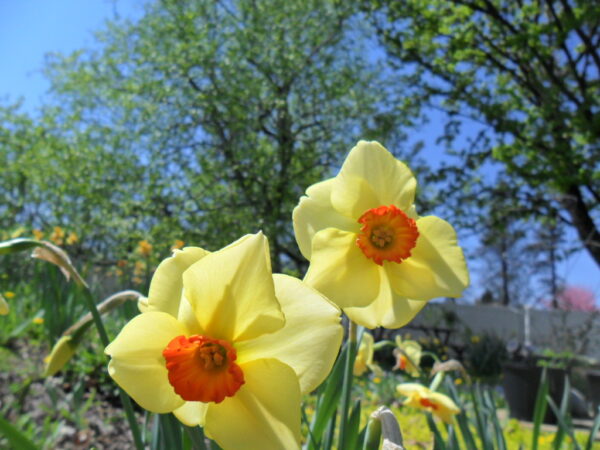
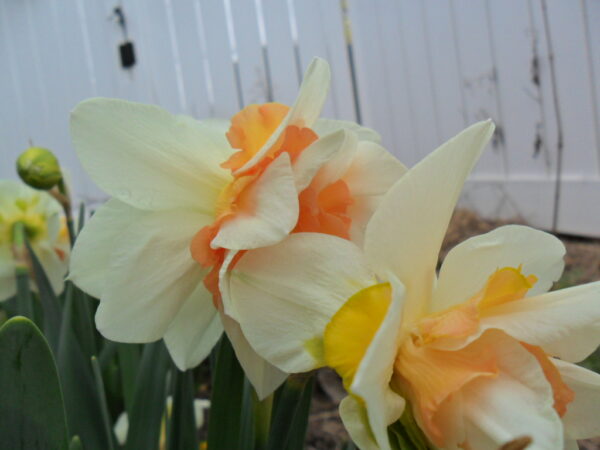
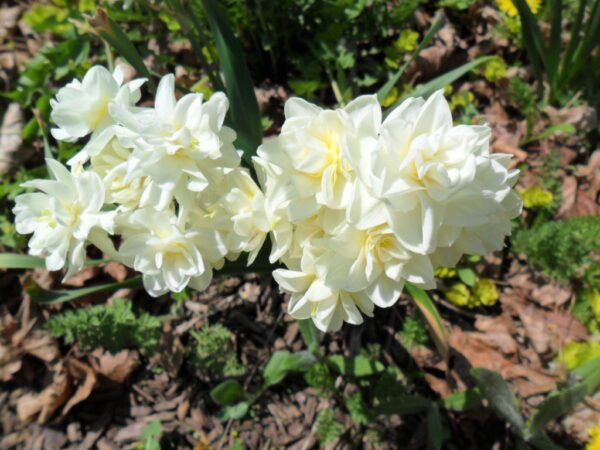
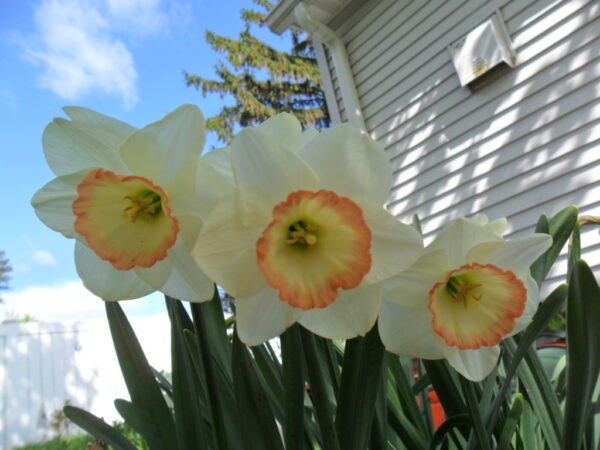
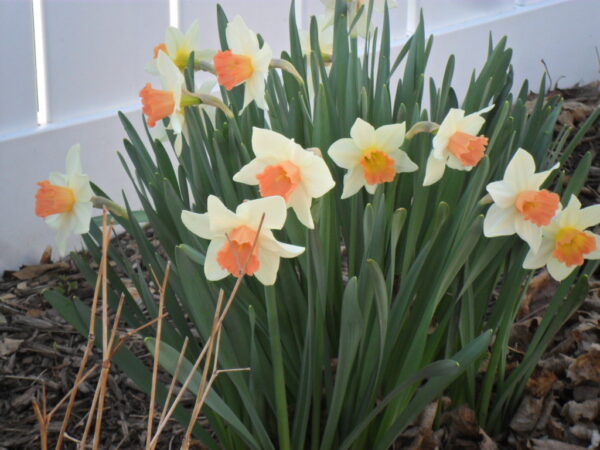
That said, there was plenty of beauty in the garden this spring, you just had to catch it while the catching was good, and take nothing for granted. To miss a day in the yard was to risk missing the peak performance of an entire species. Let me stress again – so odd!

Over all, the bulb plants did fine, just a bit of scheduling issues with their normal bloom times. There were one or two narcissus patches that just disappeared, which mystifies me – there is precious little that will eat a narcissus bulb, which is why daffodils are such popular choices for gardeners in areas where deer are a menace. So the cause of the dieback must have been environmental on some level, but since other strains crowding side by side came through the winter just fine, I have no suggestions for why some failed.

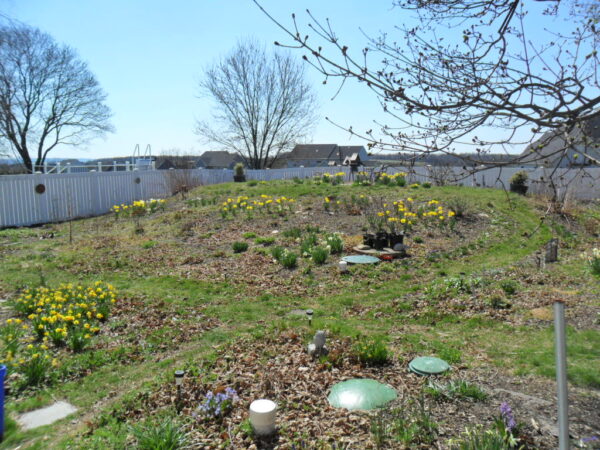
Most groundcovers returned fairly reliably, except for one of my favorites, the incomparable mazus reptans, which last year carpeted large swaths of territory in several sectors of the garden, creating gorgeous islands of medium purple blossoms in April and May, and a dense, weed-free mat for the remainder of the growing season. This year, not so much. I suspect the culprit was that polar vortex in December, with no snow cover to protect it. The rug of greenery seems to have just blistered to brown, and while there are spots of the mazus coming back, I fear they won’t fill in their old stomping grounds before other opportunistic weeds take over.
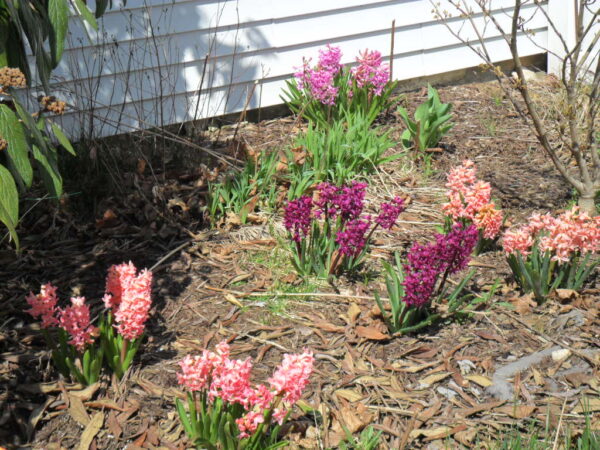

Last year’s drought doesn’t seem to have affected the woodruff and creeping jenny much, thankfully. Both are ranging far and wide from their initial plugs, though the woodruff does seem to be a little down in blooms this spring, with less of its sweet diminutive white flowers than formerly. Woodruff is a Beltane staple, used to flavor wine and punch for this pagan festival of fecundity and growth. The jenny will bloom in due course, but its vibrant yellow blossoms are so close-held to the ground, and so similar in color to its summertime foliage in lemon-chartreuse, that they’re often not noticeable.
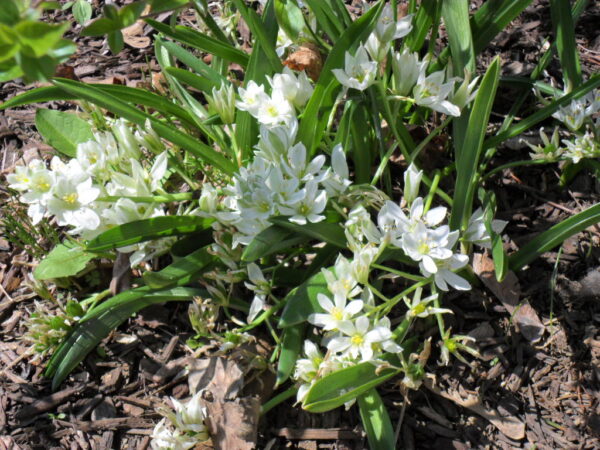


I have a trick for propagating this superlative groundcover – I came from Philadelphia with a large, low terracotta pot planted with it, and every year I set the pot in a different space. Throughout the growing season it spreads out over the lip of the pot into the surrounding soil, and takes off from there. When autumn comes, I simply trim it at the pot rim and leave what has rooted behind, carrying my “starter” to a new location for the next spring.
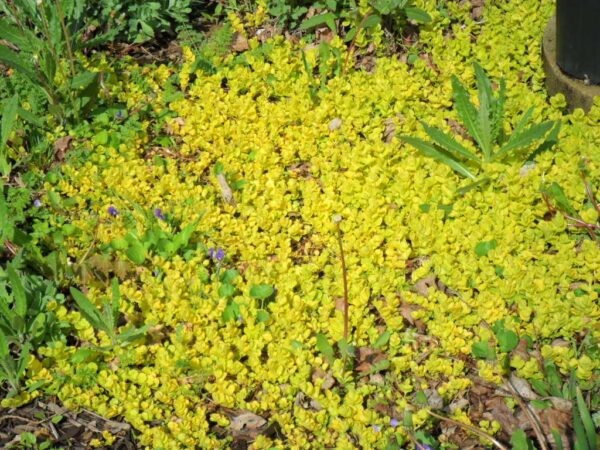

The archangel, on the other hand, is nothing if not showy. Starting with a small three-inch pot imported from Philly in 2020, this stunning variegated silver-and-green beauty has spread to completely encompass a yards-wide circle under the failing birch clump. In late April to early May it sends tall 9” spires of bright yellow blossoms skyward, with small mint-like blooms radiating along the stem in rafts, like so many floors of a high-rise apartment building.
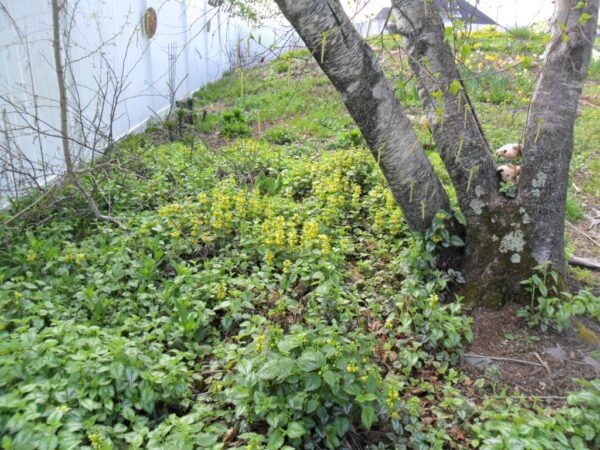
Now, at May Day, we’re moving rapidly into the late spring ephemeral season, though some of these came in well before their time and are already a dim memory, while others are running well behind, stunted by a two-week dip in temps the last half of April. The spring ephemeral season begins early for me, with some open as soon as late February to early March, and continuing into late May. These delightful plants help to fill the gap from bulb season to true summer and the daylilies, then coneflowers, rudbeckia and other perennials.
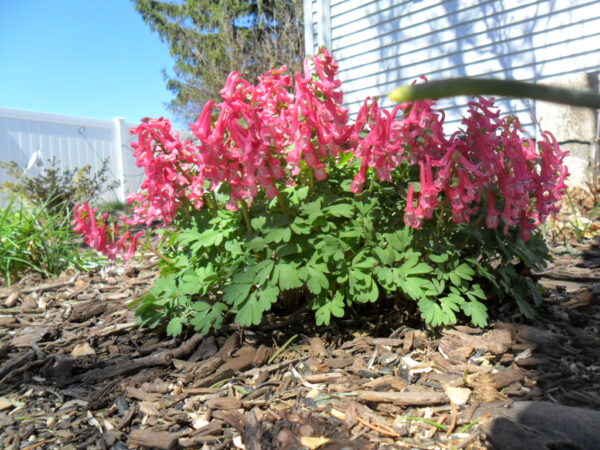
I was very pleased with the performance of the corydalis solida Beth Evans, now in its second year. It was a standout performer last spring, but I’ve seen more than a few “one hit wonders” of the plant world who excelled in their first showing, only to diminish to nothing in the aftermath. Not so the Beth Evans, a lovely mound of green-grey foliage similar to maidenhair fern, with bright coral spikes of bugle-like blooms. Corydalis is the earliest to bloom of what I would call a “herbaceous” plant – not a bulb flower, not a shrub or tree blossom – and is up and doing long before others of its kind. It bloomed later than last spring but still very early, opening in mid-March, and the variance may have been more about the bizarre variations in weather than any fault on corydalis’ part. That said, the species has proven itself and will be rewarded with a considerable number of new plants on order for fall installation, including a trial of a purple-blossomed variety.

Next up was the hellebores, which were a mixed bag. I lost one of five over the winter, but since it had struggled throughout last season, that was hardly a shock. The others returned, but only one is really thriving. That may be as well in the long run – though beautiful, hellebores are odd, in that they bloom low with downturned blossoms, making them difficult to truly enjoy unless they’re planted in an elevated bed, or you’re capable of lying flat on the ground to admire them (neither of which circumstance applies to me!).
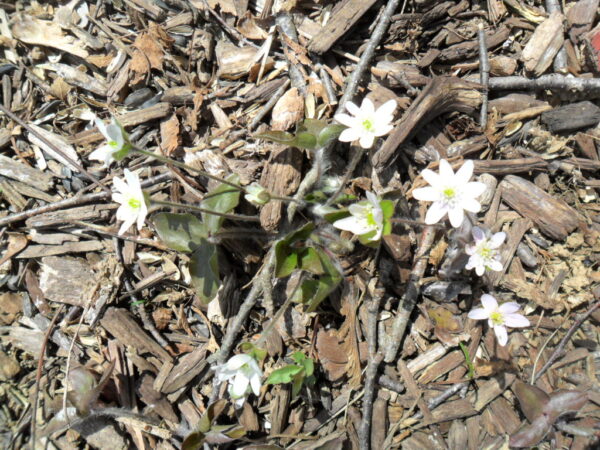
I could barely catch a breath before the hepatica acutiloba was in bloom. That’s “sharp-lobed liverleaf” to you and me, and a lovelier early spring blossom you can’t imagine. Hepatica tends to bloom on slender stems that emerge before the greenery, so are very prominent – bright, six-petaled beauties in white to palest pink (I keep calling mine “pink” to encourage them, but must ruefully admit that their true color is white). This year their premiere coincided with one of those heat bursts, so the greens popped up almost contemporaneously to the flowers, which faded in a matter of days, when standard cooler temps might have preserved them for weeks. But they were lovely while they lasted.

Yet they presented another mystery – I originally had two patches, one of which bloomed last year, and one which did not. This year, the patch that hadn’t bloomed before was covered in flowers, but the patch that did well had completely disappeared, leaving no forwarding address. Unlike many spring ephemerals, which tend to die back to the soil as summer heat comes on, hepatica remains green through most of the growing season, and I kept them well-watered during the drought, so I know that wasn’t the reason for the no-show patch. I am at a loss to understand why they abandoned me.

I also have two varieties of trillium, and while I’ve yet to see a bloom on the smaller, red-flowered reticulata species, the yellow blossoms of luteum were well in evidence this spring. Well, perhaps that’s an overstatement, as luteum tends to hide the brightest portion of its oddly-shaped flowers inside a green veneer of outer sepals. It’s a lovely addition to the garden regardless, if less than showy, with its mottled green-and-brown leaves.
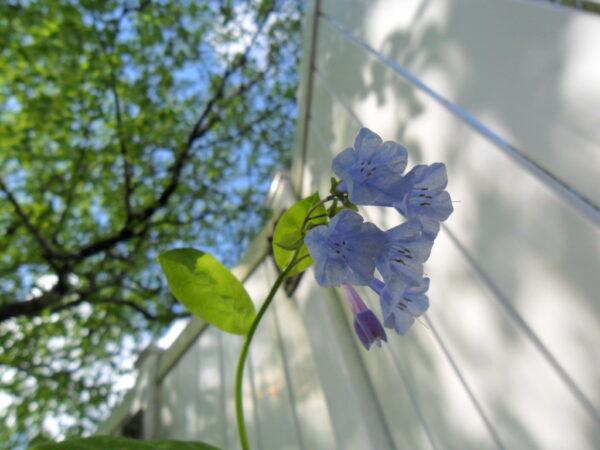
The mertensia virginica, AKA “Virginia bluebells,” also put on a show for the first time, in this, its third season here; at least, one of two patches did, though the other looks vigorous and will hopefully bloom next year. Mertensia grows in bushy clusters of large platter-shaped leaves from which willowy spikes ascend, topped with bunches of medium-blue trumpetlike blossoms, edged with pink before they open fully. The overall bloom was sparse, but definitely shows movement in the right direction.
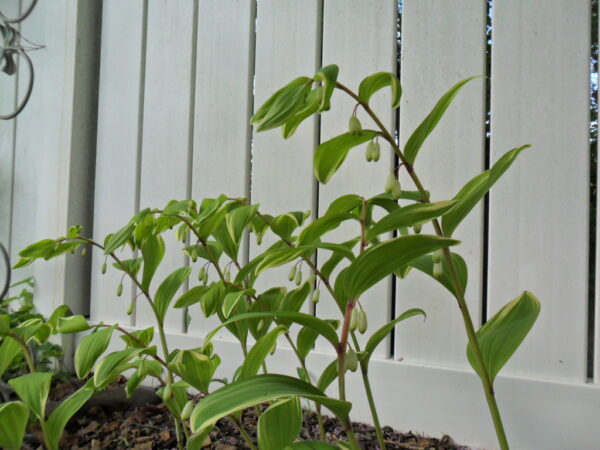
One ephemeral that leaves no doubt about its satisfaction with its new home here is polygonatum, the Solomon’s seal. This lovely May bloomer’s stems emerge in elegant arcs populated with bilateral pairs of spear-shaped variegated foliage, medium green edged in yellow-cream, interspersed with pairs of small white bell-shaped blossoms hanging pendulously between the leaves, covering roughly the top third of the stem. What began as a small clump of three stems just two years ago has spread into a fair-sized colony over the past two years.
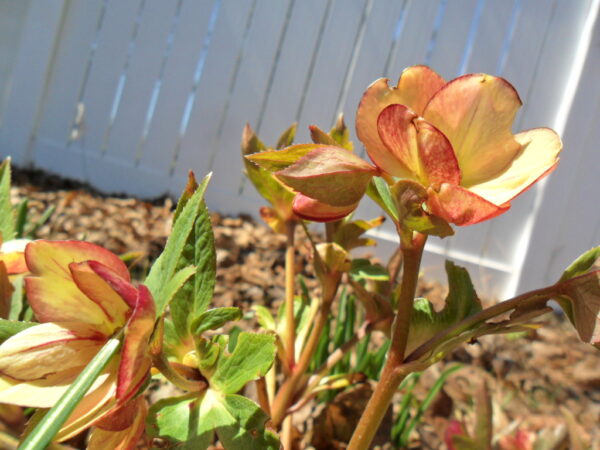
Another good performer is the hardy geranium, of which I have four varieties. The original plant, now four years old, with bright pink blooms, has developed into a well-established, vigorous mound which has started seeding offspring nearby, a sure sign of contentment with its habitat. Another has bluish-lavender flowers on graceful stems that extend well above the foliage; a third has red-tinged leaves and bright blue blossoms. These are budded now, but won’t bloom until later in the month.
The fourth, frankly, I was surprised to find this spring, since it did so poorly in its inaugural performance last summer. By fall, despite repeated waterings, it had shrunk and dried up, a seeming victim of the pervasive drought. It has the most interesting foliage, a variegation of medium green and deep purplish-brown, and diminutive but eye-catching purple blooms. Not sure what to expect of it this season, with just three leaves emerged so far, but I’m pleased to see it’s making the attempt.
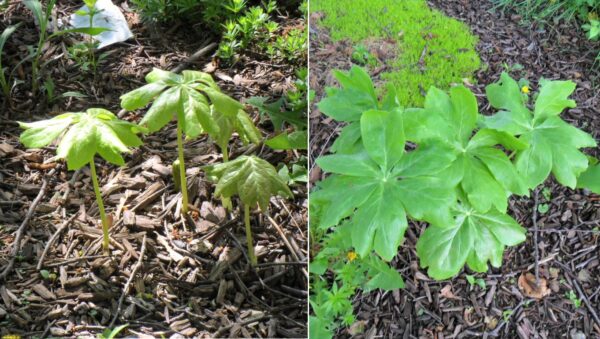
May apple (podophyllum peltatum) is a hugely underrated native that can fill in shady areas and help to keep down unwanted weeds with its parachute-like canopies, mottled in yellow-green and pale brown. When mature, these will bloom a downturned white flower that develops into a yellow-green rounded fruit resembling a Golden Delicious apple, hence the common name. Mine, now three years old, haven’t gotten that far yet (though the blooms emerge well after the foliage, so all hope is not yet lost for a crop to come later this spring), but are developing into healthy colonies that return reliably, with leaf diameters increasing yearly.
Unfortunately, my Arisaema triphyllum, Jack-in-the-pulpit, isn’t as happy with its surroundings. Jacks are among my favorites, fondly remembered from childhood woodland fishing expeditions with my father, and these are a lovely variety with purple-striped hoods encasing the green-white spadix which, when fertilized, will mature into a bumpy red garnet fruit resembling a huge raspberry. Well, that’s the theory, at any rate. So far mine are barely holding their own, most have no blooms, and those that do, wither and die before fruiting.
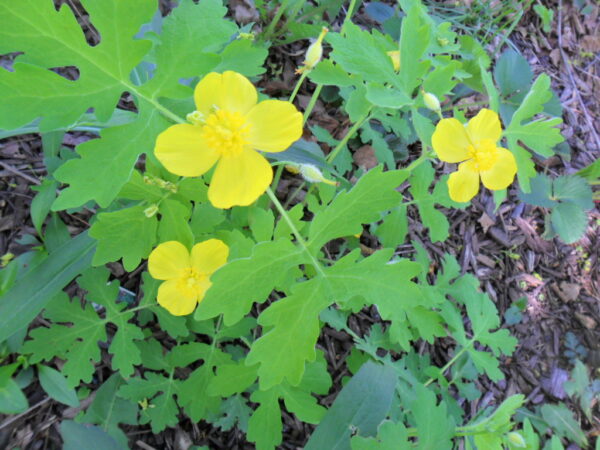
Celandine poppy is doing better, though not as well as I’d hoped, based on last year’s performance. Their incandescent golden blossoms really light up the shade garden, and in normal temperatures (whatever that means these days) their bloom period can extend for weeks. Mine burned out in about ten days this round, and the flowering was not as lush as formerly. They formed quite a few seed pods last year, which had already split and disgorged their miniscule black speck contents before I got to them, but I see no sign that any germinated. I’ll try to be more observant of their cycle this season, and grab some full pods to start them in seed trays next year.

More good news to report on the dicentra spectabilis, the ubiquitous bleeding heart. It’s taken three years, but all four of my white “alba” variety are finally in bloom! They’ll never be as vigorous as the standard bright pink variety, but I always look for something a bit unique and out-of-the-box when installing homespun heirloom plants – classic with a twist! I do have a transplant of the traditional pink as well, and it’s doing so well, I might just have to add one or two more. My experience has been that the fernleafed cultivars, with blossoms not quite so heart-shaped, never perform to expectations, but struggle year to year. A pity, because I do find them to be exceptionally lovely alternatives.
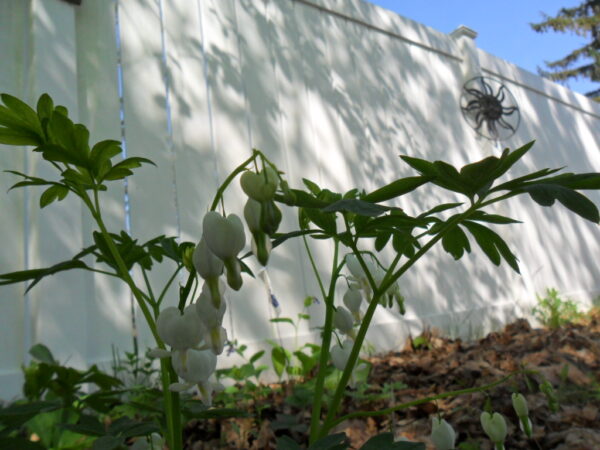
Sometimes the loveliest denizens of the garden are the wildflowers, those elements that were unplanned and volunteered to lend their grace to your cultivated space. Such is the case with violets, which dad tried unsuccessfully for years to eradicate from his lawn. I’m very thankful for that failure, because as soon as the sod was cleared and vast tracts of empty turf were available to them, these marvelous plants began to colonize with a vengeance. In addition to their exuberant purple blooms in mid-spring, violets provide an invaluable service in rooting nitrogen into the soil, enhancing plant living conditions for everyone. Mine appeared to take a serious step back with the drought last year (there were simply too many of them, too widespread, to water effectively) but have rebounded handsomely this spring; I’m even finding small new plants in previously unconquered terrain throughout the landscape.

To plant a garden is simultaneously an act of faith, and an exercise in futility. At the mercy of wind and weather, beast, bird and insect, the gardener eventually realizes, through an endless process of trial and error, what works in the space, and what must be jettisoned to make room for something more suited. Over time, granted trust and grace, something wonderful can be created.
And that is always my goal.


4 comments, add yours.
edna
Always a joy to see your garden – thanks for sharing it with us.
Irmgard Dering
Thank you so much for this wonderful video! The one from Christmas, still puts a smile on my face!
Laurien
Sorry to hear your weather has been so strange. Love spring flowers from bulbs. Enjoyed your photos so much though especially the corydalis and the daffs. Thanks for taking the time to put this together!
Charlotte
Thank you, Alex, for sharing all this gorgeousness! Flowers are the most miraculous things, aren’t they.
In the southern hemisphere, we’re going into winter now. I kindof hope it’ll be a mild one like you had – I just hope all the plants can cope…